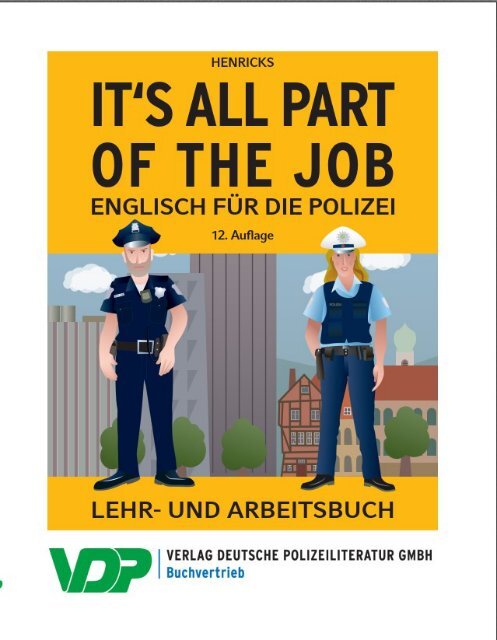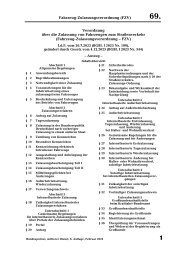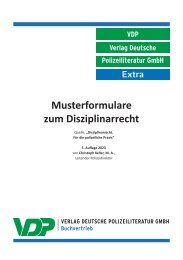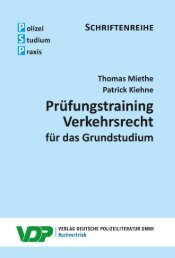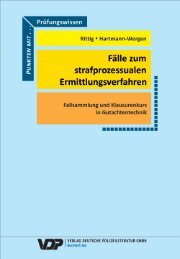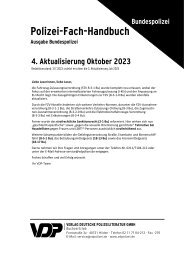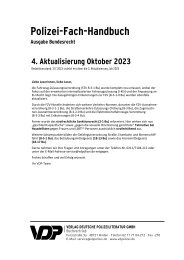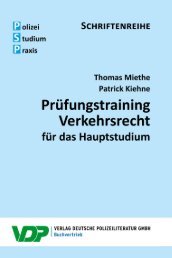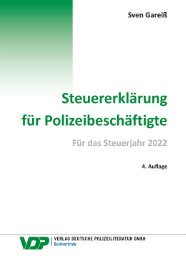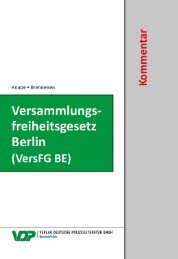It's All Part Of The Job - Leseprobe
Dieses Lehr- und Arbeitsbuch wendet sich an Lernende in der polizeilichen Aus- und Weiterbildung in Deutschland. Für die vorliegende 12. Neuauflage wurde die methodisch-didaktische Konzeption, der Inhalt und die Gestaltung durch die Autoren und den Verlag komplett überarbeitet, erneuert und um Audiodateien angereichert. Ziel der Autoren war es, möglichst praxisnahe polizeiliche Inhalte auszuwählen und aufzubereiten. Die thematische Bandbreite in den 12 Kapiteln erstreckt sich dabei von „THE BASICS OF BEING A POLICE OFFICER“ bis hin zu „TERRORISM, EXTREMISM AND POLITICALLY MOTIVATED CRIME“.
Dieses Lehr- und Arbeitsbuch wendet sich an Lernende in der polizeilichen Aus- und Weiterbildung in Deutschland. Für die vorliegende 12. Neuauflage wurde die methodisch-didaktische Konzeption, der Inhalt und die Gestaltung durch die Autoren und den Verlag komplett überarbeitet, erneuert und um Audiodateien angereichert. Ziel der Autoren war es, möglichst praxisnahe polizeiliche Inhalte auszuwählen und aufzubereiten. Die thematische Bandbreite in den 12 Kapiteln erstreckt sich dabei von „THE BASICS OF BEING A POLICE OFFICER“ bis hin zu „TERRORISM, EXTREMISM AND POLITICALLY MOTIVATED CRIME“.
- No tags were found...
Create successful ePaper yourself
Turn your PDF publications into a flip-book with our unique Google optimized e-Paper software.
IT´S ALL PART<br />
OF THE JOB<br />
Englisch<br />
für die Polizei<br />
Lehr- und Arbeitsbuch<br />
von<br />
Nick Henricks<br />
unter Mitarbeit von<br />
Martina Sebald<br />
VERLAG DEUTSCHE POLIZEILITERATUR GMBH<br />
Buchvertrieb
Bibliographische Information der Deutschen Nationalbibliothek<br />
Die Deutsche Nationalbibliothek verzeichnet diese Publikation in der<br />
Deutschen Nationalbibliographie; detaillierte bibliographische Daten<br />
sind im Internet über http://dnb.d-nb.de abrufbar.<br />
<strong>All</strong>e Audio-Dateien zu den Hörverständnisaufgaben aus diesem Buch finden Sie unter<br />
www.its-all-part-of-the-job.de<br />
www.vdpolizei.de<br />
12. Auflage 2021<br />
© VERLAG DEUTSCHE POLIZEILITERATUR GMBH Buchvertrieb; Hilden/Rhld., 2021<br />
<strong>All</strong>e Rechte vorbehalten<br />
Satz: VDP GMBH Buchvertrieb, Hilden<br />
Druck und Bindung: Beltz Grafische Betriebe GmbH, Bad Langensalza<br />
Printed in Germany<br />
ISBN 978-3-8011-0810-6
VORWORT<br />
Das vorliegende Lehr- und Arbeitsbuch wendet sich primär an Lernende in der polizeilichen Aus- und<br />
Weiterbildung in Deutschland, die ihre unterschiedlichen Fähigkeiten in der englischen Sprache konsequent<br />
erweitern und vertiefen möchten. Dies gilt sowohl für den Spracherwerb als auch für die<br />
Sprachanwendung einschließlich der englischen Grammatik. Da sich die Ausbildungsinstitutionen<br />
der deutschen Polizeibehörden und die Niveaus der Sprachlernenden maßgeblich unterscheiden<br />
können, wurde versucht passende Inhalte für eine möglichst breite Zielgruppe auszuwählen, ohne<br />
jedoch zu geringe oder zu hohe Anforderungen zu stellen.<br />
Die Neuauflage des Lehrbuchs möchte durch viele Aufgaben aus der täglichen Praxis eines Polizeivollzugsbeamten<br />
den Schwerpunkt auf eine noch praktischere Ausrichtung setzen. Damit soll ein<br />
möglichst authentischer anwendungsbezogener Kontext für das Erlernen der englischen Sprache<br />
entstehen. Ziel war es, möglichst sinnvolle polizeiliche Inhalte auszuwählen, um das Erlernte auch in<br />
der Praxis anwenden zu können.<br />
Dennoch ist es so, dass das Lehrbuch nicht die gesamten möglichen englischsprachigen Inhalte der<br />
polizeilichen Praxis wiedergeben kann. Insofern haben sich die Autoren und der Verlag auf die Darstellung<br />
der wesentlichen Tätigkeitsfelder der deutschen Polizei mit möglichem Bezug zur eng lischen<br />
Sprache beschränkt. Dies trifft auch auf ausgewählte Einzel- und Unterthemen der Kapitel zu, die im<br />
polizeilichen <strong>All</strong>tag oftmals unentbehrlich für die Sprachkompetenz im Englischen sind.<br />
<strong>All</strong>e Kapitel wurden völlig neu überarbeitet. Außerdem wurden neue Bereiche und Inhalte ergänzt,<br />
um aktuellen Entwicklungen gerecht zu werden. Die wichtigsten grammatikalischen Regeln sind den<br />
einzelnen Kapitel hinzugefügt und mit inhaltlich abgestimmten Übungen versehen, so dass Sprachenlernende<br />
und -lehrende beide Bereiche in der Sprachanwendung verknüpfen können. Darüber<br />
hinaus ist jedem Kapitel eine Vokabelliste mit einer Auswahl der wesentlichsten Wörter des <strong>The</strong>menbereichs<br />
beigefügt. Die Rechtschreibung, der Wortschatz und viele Inhalte in diesem Lehrbuch<br />
sind in der amerikanischen Sprachvariante zu Papier gebracht.<br />
Die Zusammenarbeit mit der Mitautorin war von hohem Engagement und Kooperationsbereitschaft<br />
geprägt. Der Hauptautor bedankt sich bei allen Mitwirkenden für die gute Zusammenarbeit bei der<br />
inhaltlichen Erarbeitung der Schwerpunkte und Zusammenführung bzw. Umsetzung vieler Ideen.<br />
Mit einem hohen Maß an Professionalität erfolgte auch die didaktische und methodische Überarbeitung<br />
des Lehrwerks durch Herrn Studienrat Florian Köhler.<br />
An dieser Stelle soll auch denjenigen gedankt werden, die mit Ideen, kritischen Nachfragen und<br />
fachlicher Expertise einen großen Teil zu der Entstehung des Werks beigetragen haben: Herr Richard<br />
Henricks (B.Sc.), Herr POM Daniel Henricks und Frau Natalie Henricks (Lehrerin).<br />
Im Januar 2021<br />
Nick Henricks<br />
5
INHALTSVERZEICHNIS<br />
Vorwort ..................................................................................................................................................................................................... 5<br />
Chap. 1: THE BASICS OF BEING A POLICE OFFICER<br />
1. Nuts and Bolts of Law Enforcement..................................................................................................................................11<br />
2. General Information on Police Crime Statistics (PCS 2017).....................................................................................22<br />
3. Drug Squad: An Incident on a Drug Bust....................................................................................................................... 24<br />
Chap. 2: TRAFFIC CONTROL AND VEHICLES<br />
1. Types of Vehicles and License Plates.............................................................................................................................29<br />
2. Vehicle Checks and Abiding Traffic Laws .....................................................................................................................32<br />
3. Car Accidents, Body <strong>Part</strong>s and Driver’s Licenses .......................................................................................................40<br />
Chap. 3: ILLEGAL SUBSTANCES AND ALCOHOL, GUN CONTROL<br />
1. Drug Charges and Classification in the USA.................................................................................................................47<br />
2. Driving Under the Influence of Alcohol..........................................................................................................................54<br />
3. Gun Control.............................................................................................................................................................................59<br />
Chap. 4: THEFT: PICKPOCKETING, SHOPLIFTING, BURGLARY, VEHICLE THEFT<br />
1. Pickpocketing........................................................................................................................................................................65<br />
2. Shoplifting..............................................................................................................................................................................68<br />
3. Burglary....................................................................................................................................................................................71<br />
4. Vehicle <strong>The</strong>ft..........................................................................................................................................................................75<br />
Chap. 5: INSULT, CRIMINAL ASSAULT, DOMESTIC VIOLENCE, THREAT AND STALKING<br />
1. Insult.........................................................................................................................................................................................83<br />
2. Criminal Assault....................................................................................................................................................................86<br />
3. Domestic Violence ...............................................................................................................................................................90<br />
4. Threat and Stalking..............................................................................................................................................................94<br />
6
INHALTSVERZEICHNIS<br />
Chap. 6: FIRST AID, ROBBERY, DESCRIPTION OF A PERSON, MANSLAUGHTER AND MURDER,<br />
SEX OFFENSES<br />
1. First Aid ................................................................................................................................................................................. 101<br />
2. Robbery................................................................................................................................................................................. 104<br />
3. Description of A Person.....................................................................................................................................................107<br />
4. Manslaughter and Murder ............................................................................................................................................... 109<br />
5. Sex <strong>Of</strong>fenses...........................................................................................................................................................................112<br />
Chap. 7: DEMONSTRATIONS AND POLICE TACTICS<br />
1. Demonstrations and Police Tactics in the USA........................................................................................................... 119<br />
2. Demonstrations and Police Tactics in Germany.........................................................................................................124<br />
Chap. 8: ASYLUM PROCEDURES AND POLICE MATTERS, BORDER CROSSING<br />
1. Asylum Seekers....................................................................................................................................................................135<br />
2. Asylum Procedures.............................................................................................................................................................137<br />
3. Forms of Protection and Deportation.......................................................................................................................... 138<br />
4. Border Crossing.................................................................................................................................................................. 143<br />
Chap. 9: INTERNATIONAL COOPERATION<br />
1. International Cooperation between Law Enforcement Agencies ....................................................................... 149<br />
2. Going Abroad: Police <strong>Of</strong>ficers on Foreign Assignments.......................................................................................... 154<br />
Chap. 10: ORGANIZED CRIME<br />
1. Different Forms of Organized Crime..............................................................................................................................163<br />
2. Special Types of Transnational Crime and Globalization........................................................................................173<br />
3. Predictive Policing..............................................................................................................................................................175<br />
Chap. 11: CYBERCRIME<br />
1. World of Cybercrime...........................................................................................................................................................179<br />
2. Further Threats of Cybercrime....................................................................................................................................... 185<br />
Chap. 12: TERRORISM, EXTREMISM AND POLITICALLY MOTIVATED CRIME<br />
1. General Ideas of Terrorism, Extremism and Politically Motivated Crime........................................................... 191<br />
2. Different Forms of Terrorism, Extremism and Politically Motivated Crime...................................................... 194<br />
7
TABLE OF CONTENTS<br />
TOPIC<br />
1 THE BASICS OF BEING A POLICE OFFICER<br />
1. Nuts and Bolts of Law Enforcement<br />
• An American Police <strong>Of</strong>ficer<br />
• Structure of German Law Enforcement<br />
• Equipment German Police <strong>Of</strong>ficer<br />
• Communication on the Radio – Spelling Alphabet<br />
• Time and Numbers<br />
2. General Information on Police Crime Statistics (PCS 2017)<br />
3. An Incident on a Drug Bust<br />
2 TRAFFIC CONTROL AND VEHICLES<br />
1. Types of Vehicles and License Plates in the European Union<br />
2. Vehicle Checks and Abiding Traffic Laws<br />
• Speeding Fines in the USA and Germany<br />
• Illegal Parking in Germany<br />
3. Car Accidents, Body <strong>Part</strong>s and Driver’s Licenses<br />
3 ILLEGAL SUBSTANCES AND ALCOHOL, GUN CONTROL<br />
1. Drug Charges and Classification in the USA<br />
2. Driving Under the Influence of Alcohol<br />
3. Gun Control<br />
4 THEFT: PICKPOCKETING, SHOPLIFTING, BURGLARY, VEHICLE THEFT<br />
1. <strong>The</strong>ft I: Pickpocketing<br />
2. <strong>The</strong>ft II: Shoplifting<br />
3. <strong>The</strong>ft III: Burglary<br />
4. <strong>The</strong>ft IV: Vehicle <strong>The</strong>ft<br />
5 INSULT, CRIMINAL ASSAULT, DOMESTIC VIOLENCE, THREAT AND<br />
STALKING<br />
1. Insult<br />
2. Criminal Assault<br />
3. Domestic Violence<br />
4. Threat and Stalking<br />
6 FIRST AID, ROBBERY, DESCRIPTION OF A PERSON, MANSLAUGHTER<br />
AND MURDER, SEX OFFENSES<br />
1. First Aid<br />
2. Robbery<br />
3. Description of A Person<br />
4. Manslaughter and Murder<br />
5. Sex <strong>Of</strong>fenses<br />
7 DEMONSTRATIONS AND POLICE TACTICS<br />
1. Demonstrations and Police Tactics in the USA<br />
2. Demonstrations and Police Tactics in Germany<br />
8 ASYLUM PROCEDURES AND POLICE MATTERS, BORDER CROSSING<br />
1. Asylum Seekers<br />
2. Asylum Procedures<br />
3. Forms of Protection and Deportation<br />
4. Border Crossing<br />
GRAMMAR<br />
• SENTENCE ORDER<br />
• SIMPLE PRESENT,<br />
PRESENT<br />
PROGRESSIVE, SIMPLE<br />
PAST<br />
• OBLIGATION-MUST,<br />
RULES-HAVE TO<br />
• QUESTIONS WITH<br />
QUESTION WORDS<br />
• YES/NO QUESTIONS<br />
• NUMERALS<br />
• DIFFERENT TENSES<br />
(WITHOUT FUTURE<br />
TENSE)<br />
• FUTURE FORMS<br />
• PREPOSITIONS<br />
• CONDITIONAL CLAUSES<br />
• COMPARATIVE FORMS<br />
(1): „LESS“ OR „MORE“<br />
• DEFINITE/INDEFINITE<br />
ARTICLE<br />
• RELATIVE PRONOUNS<br />
• RELATIVE CLAUSES<br />
• IMPERATIVE FORM<br />
• ACTIVE & PASSIVE<br />
VOICE<br />
• REFLEXIVE PRONOUNS<br />
• AUXILIARY VERBS<br />
• MODAL VERBS<br />
• ADVERBS<br />
• SYNONYMS<br />
• COMPARATIVE FORMS<br />
(2): COMPARATIVE AND<br />
SUPERLATIVE<br />
• REPORTED SPEECH<br />
8
TABLE OF CONTENTS<br />
TOPIC<br />
9 INTERNATIONAL COOPERATION<br />
1. International Cooperation between Law Enforcement Agencies<br />
2. Going Abroad: Police <strong>Of</strong>ficers on Foreign Assignments<br />
• At a Glance<br />
• International Police and Rule of Law Missions<br />
• Border(s) And Cross Border Cooperation<br />
• International Liaison <strong>Of</strong>ficers (Federal Criminal Police<br />
<strong>Of</strong>fice and Federal Police)<br />
10 ORGANIZED CRIME<br />
1. Different Forms of Organized Crime<br />
• Thieves in Law<br />
• Russian Mafia<br />
• Outlaw Motorcycle Gangs (OMCG)<br />
• Large Extended Families<br />
• Reversal of <strong>The</strong> Burden of Proof<br />
• White Collar Crime<br />
2. Special Types of Transnational Crime and Globalization<br />
• Money Laundering<br />
• Wildlife Crime<br />
3. Predictive Policing<br />
11 CYBERCRIME<br />
1. World of Cybercrime<br />
• Dark Net, TOR-Browser and Dark Net Markets<br />
• Different Types of Cybercrime<br />
• Arms Trade<br />
• Shooting at Munich Shopping Mall 2016<br />
2. Further Threats of Cybercrime<br />
• Cybercrime as a Service (CaaS)<br />
• German Situation Report 2017 on Cybercrime<br />
• Child Pornography on the Dark Net<br />
• Cyber-Attack on Critical Infrastructure<br />
• Malicious Software<br />
12 TERRORISM, EXTREMISM AND POLITICALLY MOTIVATED CRIME<br />
1. General Ideas of Terrorism, Extremism and Politically Motivated<br />
Crime<br />
• Radicalism, Extremism and Terrorism<br />
• Politically Motivated Crime in Germany<br />
• Terror Attacks in General<br />
• Motives of Terrorists<br />
2. Different Forms of Terrorism, Extremism and Politically Motivated<br />
Crime<br />
• Left-Wing and Right-Wing Extremism in Germany<br />
• Phenomenon “Citizens of the Reich” and “Self-Administrators”<br />
• Islamist-Motivated Terror Attacks in Germany<br />
• “Borussia Dortmund Team Bus Bombing (2017)”<br />
• Interpol Notices<br />
• Terrorist Attack in Halle (2019)<br />
GRAMMAR<br />
• INFINITIVE FORMS<br />
• PARTICIPLE<br />
• GERUND VS. INFINITIVE<br />
FORMS<br />
• MIXED GRAMMAR<br />
• TRANSLATION<br />
EXERCISES<br />
• IF -CLAUSES<br />
• PHRASAL VERBS<br />
• QUESTIONS<br />
• NOUNS + PREPOSITIONS<br />
• ADJECTIVES +<br />
PREPOSITIONS<br />
• PREPOSITION + -ING<br />
Dieses Symbol kennzeichnet Hörverständnisaufgaben, zu denen Audio-Dateien verfügbar sind.<br />
Diese können Sie unter www.its-all-part-of-the-job.de abrufen.<br />
9
CHAPTER ONE: THE BASICS OF BEING A POLICE OFFICER 01<br />
1. Nuts and Bolts of Law Enforcement<br />
Law enforcement agencies all over the world often advertise jobs with following statement:<br />
“After qualifying as a police officer, some choose to specialize in a specific branch such as a drug squad or<br />
the Criminal Investigation Department (CID). Some pass selection criteria for specialized units,<br />
for instance, Special Weapons And Tactics Team (SWAT).”<br />
Task 1:<br />
Task 2:<br />
Is this statement true in Germany as well?<br />
Tell your partner about yourself and write down the most important aspects of your partner’s<br />
profession or experience in police work.<br />
name, age,<br />
home town<br />
aspired<br />
type of work<br />
in the<br />
future<br />
type of work<br />
at the<br />
moment/<br />
experience<br />
most<br />
compli cated<br />
situation at<br />
work<br />
daily<br />
problems at<br />
work<br />
Task 3:<br />
Task 4:<br />
Introduce your partner to two other classmates! Afterwards your partner should introduce you.<br />
What do you think of your partner’s plans for the future?<br />
Read the following text about the structure of German law enforcement and complete the tasks<br />
below.<br />
Law enforcement in Germany is primarily the responsibility of the individual states but, of<br />
course, there are also federal police forces. <strong>The</strong>re are sixteen state police forces plus at least<br />
two federal police forces in Germany, not including the special police force for the premises of<br />
the German parliament in Berlin. Currently around 225,000 police officers work for state police<br />
forces and around 45,000 for federal police forces. According to German constitution the state<br />
police forces are only allowed to operate in their own states. However, there are exceptions concerning<br />
emergency measures and special types of investigations based on agreements between<br />
the states and the federal government. State police forces deal with all types of police work:<br />
traffic-related matters, petty crimes, organized crime at a state-level and other forms of serious<br />
crime. <strong>All</strong> state police forces distinguish according to their tasks between uniformed police forces<br />
and plain clothes officers.<br />
<strong>The</strong> German Federal Police, which was formerly known as Bundesgrenzschutz, have their headquarters<br />
in Potsdam and do a variety of police work: border and aviation security, riot police,<br />
protection of federal buildings and support of international police missions. <strong>The</strong> Federal Criminal<br />
Police, as federal investigative police agency of Germany, is headquartered in Wiesbaden<br />
and focuses on international organized crime, terrorism and the protection of members of the<br />
constitutional institutions.<br />
11
01<br />
CHAPTER ONE: THE BASICS OF BEING A POLICE OFFICER<br />
Police training for most recruits lasts two-and-a-half years in the regular police academy training<br />
(intermediate service). If recruits want to begin at a higher rank, they must attend police college<br />
and finish a bachelor’s degree (higher intermediate service). Only a very small percentage of<br />
police officers start their career in the highest level of service (senior service). Generally, police<br />
officers can advance to the next higher level of service if they meet the requirements and are<br />
willing to enroll into university again.<br />
1. Explain when German state police forces can operate in different states within Germany and<br />
not solely in their own. Give one example.<br />
2. Name the three different levels of police service and explain why you chose the level you are<br />
training for.<br />
Task 5:<br />
Look at the different police ranks in the United States, read the text and match the ranks below<br />
to the descriptions below.<br />
<strong>The</strong> American police system is different from the German police system. <strong>The</strong>re are various types<br />
of agencies, such as federal law enforcement agencies, state police departments, sheriff’s departments<br />
and smaller police forces like school police. <strong>The</strong> most famous American federal agency<br />
is the Federal Bureau of Investigation (FBI), but there are several more: Drug Enforcement Administration<br />
(DEA), <strong>The</strong> U.S Marshals Service or Bureau of Alcohol, Tobacco and Firearms (ATF).<br />
<strong>The</strong> American police hierarchy (order of ranks) is similar to the American military hierarchy, but<br />
varies among the sheriff’s, local, state and federal police departments and agencies. Below you<br />
can find the most common American police ranks:<br />
Captain<br />
Lieutenant<br />
Sergeant<br />
Detective/Inspector (usually plain clothes)<br />
<strong>Of</strong>ficer/Trooper/Patrolman<br />
Commissioner<br />
Deputy Commissioner<br />
Assistant Commissioner<br />
Chief Superintendent<br />
Superintendent<br />
Deputy Superintendent<br />
OFFICIAL RANK<br />
DESCRIPTION OF DUTIES<br />
…highest representative in the chain of command of a police department.<br />
…a police officer who is responsible of supervising a shift of detectives or<br />
officers.<br />
…a police officer who supervises sergeants, other police officers and an entire<br />
section of a police station.<br />
…the lowest police rank in the United States. <strong>The</strong> officers are in charge of<br />
maintaining public order and enforcing the law.<br />
12
CHAPTER ONE: THE BASICS OF BEING A POLICE OFFICER 01<br />
Task 6:<br />
Study the following picture in detail. It shows the equipment of a German police officer on the<br />
floor. Match the words below with the numbers in the picture. Which type of this equipment is<br />
only used in special occasions, like riots?<br />
equipment belt<br />
bullet-proof vest<br />
uniform<br />
badge<br />
handcuffs<br />
holster<br />
handgun<br />
baton<br />
radio<br />
pepper spray<br />
gloves<br />
(spare) magazine<br />
helmet<br />
shin-pad/elbow pads<br />
body camera<br />
shield<br />
Abbildung 1: Polizist mit Ausrüstung<br />
Task 7:<br />
<strong>The</strong> text below describes a typical day of a German police officer in uniform.<br />
Read the text and explain the following words:<br />
intermediate service patrolman shift<br />
domestic violence traffic accidents alerted<br />
self-defense skills arresting techniques first responder<br />
(to) deal with people handgun equipment<br />
Working as a German police officer in uniform usually means working different shifts in a single<br />
week. This applies to the majority of police officers because the tasks simply require a certain<br />
flexibility and commitment to your profession.<br />
Let us have a look at police officer David Schneider, who works in the intermediate service of<br />
the Bavarian police as patrolman. He works in a three-shift system with a two day off time period<br />
in between the shift blocks. This means officer Schneider starts with a late shift the first day<br />
(1200 – 1900) and works a morning and night shift the following day (0600 – 1200; 1800 – 0600).<br />
So, after those three shifts he can spend two full days at home before the shift combination<br />
starts all over again. This line of work can be very stressful. Especially if you have major brawls,<br />
domestic violence cases, or traffic accidents at the end of a shift. Frequently the officer alerted<br />
must stay at the scene until all the problems are handled. Once officer Schneider returns to<br />
the police station, he still has to write reports, fill out forms and make sure all his equipment is<br />
stored properly after taking it off. He cannot take the handgun home with him but has to lock it<br />
away at the beginning and at the end of every shift.<br />
Additionally, police officers in Bavaria have special training days which allow them to exercise<br />
their self-defense skills, arresting techniques and first-responder medical abilities. But officer<br />
Schneider also explains that apart from all these capabilities police officers in uniform really<br />
13
01<br />
CHAPTER ONE: THE BASICS OF BEING A POLICE OFFICER<br />
need social skills: “We have to be able to read people and know how to react in different situations<br />
when we are dealing with people. That’s the key to being a good and successful police<br />
officer“.<br />
Task 8:<br />
Read the text above again. Describe the line of work of a German police officer on the basis of<br />
David Schneider‘s schedule. Name the advantages and disadvantages of this kind of work.<br />
Task 9:<br />
Are the following statements from the text true or false? Correct them if necessary.<br />
A. As a police officer in uniform, you can leave from work immediately when your shift ends.<br />
B. Most police officers in uniform take their gun home with them.<br />
C. <strong>The</strong> key to being a good and successful police officer is to never back down and always punish<br />
every single petty crime you notice.<br />
D. In Bavaria training days for police officers in uniform include arresting techniques and firefighting<br />
skills.<br />
Task 10: Read the following text about an American police officer. Highlight words you are not familiar<br />
with.<br />
Rick Smith (Police <strong>Of</strong>ficer from Los Angeles) – a Daily Routine<br />
I really don’t like to work on the weekends, but we work a rotating system.<br />
Three 10-hour shifts in a row, two days off; then we restart. This<br />
changes monthly depending on if it’s night or day shift.<br />
Suit Up: I have a brother who was in the U.S. Army, and we have discussed<br />
at length and figured out that being a beat cop in LA is way more<br />
dangerous than being an Army grunt, even in a combat zone. <strong>The</strong> stuff I<br />
do, compared to the stuff he did, presents daily situations that could at<br />
any time warrant pulling a gun. And my brother “pulled a gun.” Your gun<br />
is always out and on the ready as a soldier, and he never returned fire on<br />
an enemy. Whereas, if I pull my gun, it’s because a situation may warrant<br />
me pulling the trigger.<br />
Abbildung 2: Amerikanischer<br />
Polizist im Einsatz<br />
I carry a Beretta 92FS 9-millimeter pistol, and yes, I take some flak on the force for carrying such<br />
a small caliber weapon. But it’s a regular Army issue pistol, and my brother and I both own one.<br />
Before I became a cop, it was the one I was most accurate with on the range.<br />
My brother and I hunted small game a bit in northern Cali with an AR-15 while growing up, so I<br />
carry a Smith & Wesson M & P 15T rifle (fully automatic) in the trunk of my squad car.<br />
I leave the house in civilian clothes, although my neighbors know I’m a policeman – and don’t<br />
take my uniform items with me in the police station. Flak vest, utility belt items, handcuffs, and<br />
so forth are maintained and kept locked up at the station at all times.<br />
Weapons checks, roll call, and then my partner and I are on patrol. We have a route that takes us<br />
through areas with gang activity, so the second we leave the station we go on alert.<br />
14
CHAPTER ONE: THE BASICS OF BEING A POLICE OFFICER 01<br />
Roll Call: I start my day at roll call, which is just a short meeting where supervisors ensure everyone<br />
is present for duty. This might sound like a duh, but people catch colds in LA just like the<br />
rest of the planet, and then we have to figure out who is rolling with who to fill in for missing<br />
personnel. <strong>The</strong>re is always a short training session during a roll call, a current events update, and<br />
a general safety brief.<br />
Patrol Car: Everyone wants to drive the Dodge Chargers, but I almost always end up with one<br />
of the older model Ford sedans. I check my engine oil, other fluids, and tire pressure – although<br />
everyone else on the force usually allows our maintenance section to do their job.<br />
Location Device: We use a standard emergency vehicle navigation system, which is tricky to use,<br />
but absolutely necessary in many scenarios.<br />
On Patrol: My official daily duties consist mostly of gathering information on gang activity to<br />
insert into the big picture computers at the police station. On the ground, we use printouts with<br />
crime lists on one side (specific crimes, modus operandi, etc.), and crime maps on the other side<br />
(our police division locations, crime locations, times, etc.). Specific crimes we are aware of include<br />
grand theft auto, attempted murders, robberies, home invasions, and so forth.<br />
While on patrol gathering information, we look for new gang graffiti and rival gang interactions<br />
that may potentially evolve into violence. We watch everyone, and, of course – everyone watches<br />
us.<br />
If we’re on an evening shift, everything changes and becomes more dangerous as it turns dark.<br />
Lunch: We pull security for each other during lunch breaks. Flip a coin, and Squad Car 101 watches<br />
out for loonies for Squad Car 202, so 202 can take a break and enjoy lunch.<br />
Lunch: We pull security for each other during lunch breaks. Flip a coin, and Squad Car 101 watches<br />
out for loonies for Squad Car 202, so 202 can take a break and enjoy lunch.<br />
End of Shift: <strong>The</strong> end of every day is the worst part of the job, mostly because of the amount of<br />
paperwork required.<br />
Task 11:<br />
Match the following definitions to the words below.<br />
beat cop<br />
Army grunt<br />
(to) warrant<br />
squad car<br />
flak vest<br />
utility belt items<br />
sedan<br />
maintenance section<br />
loonies<br />
A vehicle used by police, equipped with a radio telephone for communication.<br />
A protective, bullet-proof vest.<br />
<strong>The</strong> department of the police which takes care of vehicles.<br />
A police officer who works in uniform (typically in the busy streets of a large city).<br />
Usually a soldier in the Army infantry.<br />
To give reason or sanction for doing something.<br />
A variety of useful devices that can be attached to a belt.<br />
Short for lunatics.<br />
A special type of car with two or four seats usually with a notchback.<br />
15
01<br />
CHAPTER ONE: THE BASICS OF BEING A POLICE OFFICER<br />
Task 12: Read the text again. Compare the equipment of the American officer in the text to the German<br />
officer in uniform mentioned above. What are the major differences and similarities?<br />
Task 13: Describe what the official daily duties consist of. <strong>The</strong>n explain which crimes the police officers<br />
are aware of. Answer the task using your own words as far as it is appropriate.<br />
Task 14: Read the text again and phrase questions for the answers below:<br />
– “Flip a coin” – “Roll call” – “Suit up”<br />
Example: “Location device”<br />
Ú What do you call a standard emergency vehicle navigation system?<br />
1.<br />
2.<br />
3.<br />
16
CHAPTER ONE: THE BASICS OF BEING A POLICE OFFICER 01<br />
Task 15: Listen to the following description of how to become a police officer in the United States.<br />
Take notes on the following aspects:<br />
1. main responsibilities of a police officer:<br />
2. tasks of a police officer:<br />
3. minimum qualifications of a police officer:<br />
4. aspects of training at the police academy:<br />
Task 16: Communication on the radio and knowing the spelling alphabet is essential for becoming a police<br />
officer. Fill in the grid below. Do you know what all the letters stand for?<br />
alphabetic<br />
character<br />
German NATO alphabetic<br />
character<br />
German<br />
NATO<br />
A<br />
O<br />
Ä<br />
Ö<br />
B<br />
P<br />
C<br />
Q<br />
D<br />
R<br />
E<br />
S<br />
F<br />
T<br />
G<br />
U<br />
H<br />
Ü<br />
I<br />
V<br />
J<br />
W<br />
K<br />
X<br />
L<br />
Y<br />
M<br />
Z<br />
N<br />
17
01<br />
CHAPTER ONE: THE BASICS OF BEING A POLICE OFFICER<br />
Task 17: Spell out ten words below either using the German or NATO spelling alphabet.<br />
Work with a partner you usually do not work with.<br />
victim offender criminal investigation pilferage<br />
shift supervisor secure traces BA–NI 652 fake firearm<br />
preliminary arrest custody investigative custody bodily harm<br />
withdrawal symptoms customs counter eyewitness<br />
legal guardian limit driving ban expired<br />
charge sheet intoxication damage interrogation<br />
rival groups violence-prone fan clash spectator<br />
blackjack prosecutor syringe penal code<br />
age of consent disorderly conduct armed robbery refugee<br />
adultery manslaughter rapist injury<br />
deportation felony misdemeanor/offense racial appearance<br />
Task 18: Pick three words and explain the meaning of the words as clearly as possible.<br />
Task 19: Listen to an officer of the Los Angeles Police Department (LAPD) explaining how to contact him<br />
and his department. Take notes on the following aspects:<br />
a. <strong>Of</strong>ficer Brown’s first name and the name of his partner:<br />
b. Phone number to contact him:<br />
c. Personal email address of <strong>Of</strong>ficer Brown:<br />
d. Phone number of anonymous tip-hotline:<br />
e. Phone number of suicide hotline:<br />
f. Email address of “Battered Women Hotline” and name of <strong>Of</strong>ficer you will reach by calling hotline:<br />
Task 20: Look at the digital displays and read the times aloud. Do you know at least two different ways of<br />
expressing the time?<br />
1200<br />
0600<br />
1330<br />
1515<br />
1610<br />
1740<br />
2045<br />
11:30<br />
0905<br />
08:18<br />
23:42<br />
1606<br />
0345<br />
00:00<br />
Extra question: What do “a.m.” and “p.m.” stand for?<br />
18
CHAPTER ONE: THE BASICS OF BEING A POLICE OFFICER 01<br />
Task 21: Read the following numbers out loud. Work with a partner and alternate. Correct him/her if<br />
necessary.<br />
3,567 642 88,745 220,005 8,000<br />
44,230 773,120 11,043 1,000,000 6,240,200<br />
3,500 48 3,587,090 27,000 138,000,031<br />
Task 22: Two police officers are having a short conversation about a colleague in a patrol car. Fill in the<br />
gaps using the given verbs. Use the following three tenses: Simple Present, Simple Past, Present<br />
Progressive.<br />
A short conversation in a patrol car<br />
1. It doesn’t matter how much coffee he drinks, he always (get) tired during the night<br />
shifts.<br />
2. That’s right. But right now, he is on day shift and it’s ten o’clock in the morning. Look at him!<br />
He<br />
(yawn)!<br />
3. Come on, Mike. Give him a break. He always you (help out) whenever<br />
you ask him.<br />
4. That’s not right, Cindy. I asked him several times to take my shift and he always (say)<br />
no to me. I think that he doesn’t like me.<br />
5. Well, that would be understandable after you (play) that dirty trick on him last<br />
week.<br />
Kapitel X, task 22<br />
GRAMMAR HELP:<br />
SEE CHAPTER ONE –<br />
GRAMMAR BASICS<br />
6. Every day I (apologize) for it. Sometimes I apologize several times in one<br />
shift. He<br />
(be) still mad and won’t talk to me.<br />
7. Okay, I understand. But, do know this: He even (not talk) to me right now<br />
because I (drive) in a patrol car together with you. Maybe we should talk to him<br />
later one more time and try to<br />
(solve) this issue.<br />
8. I (try) a final attempt last week and it (do not work). I think I will just<br />
wait until he<br />
(come around).<br />
Abbildung 3: Konversation im Streifenwagen<br />
19
01<br />
CHAPTER ONE: THE BASICS OF BEING A POLICE OFFICER<br />
Task 23: Translate the following sentences into correct English. Use the auxiliaries “must“, “have to“,<br />
“should“ and “(to) be allowed to“ for the German translation. <strong>The</strong> English words below should<br />
help you.<br />
Bedauerlicherweise muss ich dieses Wochenende arbeiten, weil mein Name im Schichtplan steht.<br />
Du musst uns unbedingt bald im Polizeihauptrevier besuchen kommen. Ich bitte dich!<br />
Es ist Ihnen nicht erlaubt hier vorbei zu gehen, da hier aktuell polizeiliche Maßnahmen stattfinden.<br />
Sie sollten sich beruhigen und nicht weiter herumschreien. Ansonsten muss ich Ihnen Handfesseln<br />
anlegen.<br />
In einer großen Stadt wie Los Angeles sollte man nicht so viel Bargeld mit sich führen.<br />
Sie verhalten sich sehr ungewöhnlich. Ich muss Sie nun bitten aus dem Fahrzeug auszusteigen. Sie<br />
dürfen nicht weiterfahren.<br />
strangely<br />
cash<br />
police measures<br />
shift schedule<br />
police headquarters<br />
(to) handcuff<br />
20
CHAPTER ONE: THE BASICS OF BEING A POLICE OFFICER 01<br />
Task 24: Read the sentence and ask a question. Write down the question and let your partner answer it.<br />
Example:<br />
We barely made it for “roll call” because Anthony was late again.<br />
A: Why did you barely make it for “roll call”?<br />
B: We barely made it because Anthony was late again.<br />
Mike couldn’t fire his gun because the firing pin was broken.<br />
A: Why couldn’t Mike fire his gun?<br />
B: He couldn’t fire his gun because the firing pin was broken.<br />
I almost shot a young man yesterday because he was carrying a knife in his pocket.<br />
Why…<br />
Cindy cleans her gun and all other important equipment every day.<br />
How often…<br />
An empty magazine was found in the backpack of an adult male.<br />
What…<br />
Susan couldn’t arrest the felon because he was 6’4” tall and weighed 250 pounds.<br />
Why…<br />
Drug related crimes are often committed during the night.<br />
When…<br />
He wishes he had more officers to patrol this area, especially the south of Los Angeles.<br />
Which…<br />
<strong>The</strong> Human Resources office is constantly looking for more personnel in the field.<br />
Who…<br />
LAPD used to recruit ex-military personnel in the late nineties.<br />
When…<br />
21
01<br />
CHAPTER ONE: THE BASICS OF BEING A POLICE OFFICER<br />
2. General Information on Police Crime Statistics (PCS 2017)<br />
Task 25: General Information on Police Crime Statistics (PCS): Look at the chart below and translate<br />
Task 25: the General different Information criminal offenses on Police into German. Crime Statistics <strong>The</strong>n comment (PCS): on Look the at numbers. the chart below and translate the<br />
different criminal offenses into German. <strong>The</strong>n comment on the numbers.<br />
0,1%<br />
3,1%<br />
1%<br />
PCS 2017 - General Information on Police Crime<br />
Statistics<br />
total offenses (5,761,984 cases)<br />
18%<br />
10%<br />
6%<br />
10%<br />
bodily injury<br />
drug offenses<br />
damage to property<br />
fraud<br />
36%<br />
15,8%<br />
theft<br />
offenses against sexual selfdetermination<br />
offenses against life<br />
offenses against foreigner's law<br />
Quelle: Polizeiliche Kriminalstatistik (2017), herausgegeben vom Bundeskriminalamt<br />
1. 2. 3.<br />
4. 5. 6.<br />
7. 8. 9.<br />
others<br />
Task 26: Listen and complete the following tasks below.<br />
1. Briefly explain the aim of the “General Information on Police Crime Statistics (PCS)”.<br />
22
CHAPTER ONE: THE BASICS OF BEING A POLICE OFFICER 01<br />
2. True or false? Tick the correct answer.<br />
true<br />
false<br />
<strong>The</strong> information is mainly gathered for law enforcement purposes<br />
and to make sure the right decisions are made.<br />
<strong>The</strong> police crime statistics are so-called “ingoing statistics”.<br />
<strong>The</strong> total clear-up rate is around 85.1 % (2016: 56.2%).<br />
3. Fill in the gaps.<br />
<strong>The</strong> PCS also do not include _______________ which do not fall within the competency of the<br />
police (e.g. financial and tax offenses) or which are reported directly to the public prosecutor‘s<br />
office and are _______________ exclusively by the public prosecutor‘s office (e.g. perjury).<br />
<strong>The</strong> PCS contain, in particular, information about:<br />
– the type and number of recorded _______________ _______________,<br />
– the date and place of the offense,<br />
– the _______________ and criminal damage,<br />
– the clear-up rate,<br />
– the _______________ age, gender, nationality and other characteristics.<br />
Crime trends in 2017 have developed quite differently:<br />
In general, the total number of recorded criminal offenses _______________ by 9.6% compared<br />
to the previous year (2017: 5.763 million cases, 2016: 6.373 million cases). <strong>The</strong> total number of<br />
recorded _______________ _______________ excluding offenses against foreigner’s law decreased<br />
by 5.1 % compared to the previous year (2017: 5.582 million cases, 2016: 5.885 million<br />
cases).<br />
4. Tick the two correct options.<br />
□ Significant changes compared to the previous year include a slight raise of drug offenses.<br />
□ Significant changes compared to the previous year include a slight decrease of drug offenses.<br />
□ Additionally, a further raise of economic crime.<br />
□ Additionally, a further reduction of economic crime.<br />
23
01<br />
CHAPTER ONE: THE BASICS OF BEING A POLICE OFFICER<br />
3. Drug Squad: An Incident on a Drug Bust<br />
Task 27:<br />
Listen to the text “A Regular Drug Bust“ and answer the questions below. Before you start look<br />
at the title. What do you expect the story to be about?<br />
1. Describe the relationship between the district attorney and the police.<br />
2. Clarify the term “arrest warrant” according to the text.<br />
3. Explain what the officers were looking for and how they knew about it.<br />
4. List the synonyms used for cocaine.<br />
5. Fill in the gap with the suitable term and explain it in your own words.<br />
A: Can’t promise you that. But we won’t arrest you for_________________________________<br />
C: Oh, for Christ’s sake. She is in the back. In the room behind the bar. I never go in there.<br />
A: Wow, was that really that hard, honey?<br />
extra question: What is your opinion about the arrest warrant?<br />
24
CHAPTER ONE: THE BASICS OF BEING A POLICE OFFICER 01<br />
KEY WORDS CHAPTER -1-<br />
baton<br />
bodily injury/assault (and battery)<br />
bullet-proof/flak vest<br />
Criminal Investigation Department (CID)<br />
damage to property<br />
disorderly conduct<br />
drug offenses<br />
equipment/utility belt<br />
firearms training<br />
fraud<br />
German Federal Criminal Police <strong>Of</strong>fice<br />
German Federal Police<br />
higher intermediate service<br />
intermediate service<br />
senior service<br />
legal force<br />
offenses against foreigner’s law<br />
offenses against sexual self-determination<br />
police headquarters<br />
police station<br />
theft<br />
three-shift system<br />
violence<br />
Schlagstock<br />
Körperverletzung<br />
Schutzweste<br />
Kriminalpolizei<br />
Sachbeschädigung<br />
Ruhestörung<br />
Rauschgiftdelikte<br />
Einsatzgürtel<br />
Ausbildung an der Waffe<br />
Betrug<br />
Bundeskriminalamt<br />
Bundespolizei<br />
gehobener Dienst<br />
mittlerer Dienst<br />
höherer Dienst<br />
unmittelbarer Zwang<br />
ausländerrechtliche Verstöße<br />
Verstöße gegen die sexuelle Selbstbestimmung<br />
Polizeihauptrevier<br />
Polizeirevier<br />
Diebstahl<br />
Dreischichtsystem<br />
Gewalt<br />
25
01<br />
CHAPTER ONE: THE BASICS OF BEING A POLICE OFFICER<br />
CHAPTER ONE – GRAMMAR BASICS<br />
TENSES<br />
PRESENT<br />
PAST<br />
SIMPLE PRESENT<br />
regularly, normally, every year, often<br />
Wiederholte oder einmalige Handlung in der Gegenwart<br />
Gesetzmäßigkeiten und Tatsachen<br />
SIMPLE PAST<br />
yesterday, last year, in 2018 ago<br />
Einmalige/wiederholte Handlung<br />
in der Vergangenheit (abgeschlossen)<br />
Aufeinander folgende Handlungskette in der Vergangenheit.<br />
“He often goes to the gym.<br />
Sound travels faster than the bullet.“<br />
“Five Years ago he became a police officer.“<br />
SIMPLE PRESENT PROGRESSIVE<br />
now, at the moment, this week<br />
SIMPLE PAST PROGRESSIVE<br />
Betonung der Zeitdauer<br />
Handlung dauert länger an und ist noch nicht abgeschlossen<br />
Betonung der Zeitdauer<br />
(oft in Kombination mit dem Simple Past)<br />
“<strong>The</strong>y are running away from the police“<br />
“<strong>The</strong> victim was watching television<br />
when he was murdered.“<br />
26
Does our shift start at seven o’clock?<br />
Do we need to file this report?<br />
Are you in charge here?<br />
Is this your superior officer?<br />
Why did you react in this way?<br />
How often do you clean your equipment?<br />
What was found in the suitcase?<br />
Where are most crimes committed?<br />
How often are you on night shift?<br />
Yes/No questions<br />
CHAPTER ONE: THE BASICS OF BEING A POLICE OFFICER 01<br />
Yes, it does. / No, it doesn’t.<br />
Yes, we do. / No, we don’t.<br />
Yes, I am. / No, I am not.<br />
Yes, it is. / No, it is not.<br />
Questions with question words<br />
(‘what’, ‘where’, ‘when’, ‘why’, ‘who’, ‘which’, ‘how’, ‘how much’, ‘how many’)<br />
… because I felt threatened.<br />
Several times a week.<br />
A plastic bag with metal pieces in it.<br />
Most crimes are committed in big cities.<br />
Twice a week.<br />
Must vs. have to<br />
Both must and have to express obligation or requirement,<br />
but there are some small differences:<br />
• must expresses the speaker's feelings, whereas have to normally expresses an objective idea:<br />
Must I wear this uniform? Am I obliged to wear this uniform? (What do you think?)<br />
Do I have to wear this uniform? Am I obliged to wear this uniform?<br />
(Is there a rule about uniforms at the police?)<br />
• have to mainly expresses general duties or requirements, while must is used for specific obligations:<br />
I have to take a shower once a day.<br />
I must tell her about you.<br />
negative forms: mustn‘t and don‘t have to<br />
• mustn‘t expresses prohibition: You mustn‘t enter. You are not allowed to enter.<br />
• don‘t have to expresses the absence of obligation or necessity:<br />
You don‘t have to come inside. You are not obliged to come inside<br />
(but you can if you want to).<br />
Remember: “In a non-smoking area you mustn’t smoke, but in a<br />
smoking area you don’t have to smoke but you can if you want to.”<br />
27
CHAPTER TWO: TRAFFIC CONTROL AND VEHICLES 02<br />
1. Types of Vehicles and License Plates<br />
Task 1:<br />
Look at the different types of cars. Match them with the pictures.<br />
1<br />
4<br />
7<br />
10<br />
13<br />
2<br />
5<br />
8<br />
11<br />
14<br />
3<br />
6<br />
9<br />
12<br />
15<br />
1. _______________________________________<br />
2. _______________________________________<br />
3. _______________________________________<br />
4. _______________________________________<br />
5. _______________________________________<br />
6. _______________________________________<br />
7. _______________________________________<br />
8. _______________________________________<br />
9. _______________________________________<br />
10. _______________________________________<br />
11. _______________________________________<br />
12. _______________________________________<br />
13. _______________________________________<br />
14. _______________________________________<br />
15. _______________________________________<br />
Abbildung 1: Übersicht Automodelle<br />
extra question:<br />
Which type of car is not mentioned<br />
above but very popular in Germany?<br />
_____________________________<br />
big truck minivan supercar<br />
pickup roadster campervan<br />
truck coupé cabriolet<br />
van micro CUV (Crossover Utility Vehicle)<br />
SUV (Sports Utility Vehicle) hatchback sedan<br />
Task 2:<br />
Find other vehicles that can be seen regularly on German streets!<br />
Task 3:<br />
Read the following text and match the definitions below to the highlighted words from the text.<br />
“Traffic in Europe: Stuck and Going Nowhere?”<br />
Traffic jams in Europe can become very bad and for the majority of people it’s simply no fun<br />
being stuck in a four-way-lane. Some cities in Europe are actually good at avoiding major traffic<br />
29
02<br />
CHAPTER TWO: TRAFFIC CONTROL AND VEHICLES<br />
jams due to good city planning and reacting quickly in cases of serious accidents. But there are<br />
other cities, such as London, Paris or Moscow, that just cannot handle the sheer emergence of<br />
thousands of cars at the same time around rush hour. Recent data from 2018 shows that drivers<br />
in all of the three capitals spend more than two entire days per year being stuck in traffic. Each<br />
city is working actively on solving their individual problems with traffic tie-ups, gridlocks, bottlenecks<br />
and congestions. Ideas range from rebuilding whole city maps, diversifying transport use<br />
to plainly allowing only even numbers on license plates to drive on one day and uneven numbers<br />
on the other day. Although traffic in Germany may not be as bad as in Russia, it still is far<br />
away from flawless.<br />
German automobile club ADAC has released figures on traffic jams for 2017 that reveal an average<br />
of 4,000 kilometers of bumper-to-bumper traffic on Germany’s roads every day. Summertime<br />
seems to be especially problematic and often lets German drivers forfeit. <strong>The</strong> weekends<br />
seemed to have a lower number of traffic problems than the regular weekdays.<br />
a. A high number of vehicles so obstructed that they can barely move<br />
b. A narrow entrance or passageway in traffic<br />
c. Any situation in which nothing can move or proceed in any direction<br />
d. A temporary slowing or stoppage of traffic<br />
e. <strong>The</strong> appearance of more vehicles<br />
f. A tag out of metal bearing evidence of official registration<br />
g. Finding other means of (public) transport<br />
Task 4:<br />
Answer the following questions on the text:<br />
a. Name reasons for a smaller number of traffic jams at the weekend.<br />
b. Explain the main problems of traffic jams in Russia.<br />
c. Give reasons why summertime is especially problematic.<br />
30
CHAPTER TWO: TRAFFIC CONTROL AND VEHICLES 02<br />
Task 5:<br />
Read the text below and then look at the license plate. Fill in the blanks with the required<br />
information.<br />
“License Plates in the European Union“<br />
A standard format for license plates is necessary throughout the European Union‘s member<br />
states. It is a symbol for the solidarity for the European Union. More importantly, public authorities<br />
can process cross-border license plates easier. <strong>The</strong> Vienna Convention on Road Traffic<br />
(signed 1968) is meant to establish and maintain road safety by applying generic standard traffic<br />
rules among the participating parties. Most of the European member states have signed and<br />
ratified the treaty or are at least abiding the treaty as a non-state-party.<br />
7.<br />
8.<br />
3.<br />
4. 5.<br />
1.<br />
2.<br />
6.<br />
1. se_ _ of reg _ _ _ _ _ _ _ _on 5. ran_ _ _ let_ _ _s and num_ _rs<br />
2. vehi_ _ _ safety inspec_ _ _ _ s_ _l 6. _lack let_ _ _s / _ _ite bac_gr_ _ nd<br />
3. count_ _ c_ _e 7. sta_ _ of the E_ _ _pean U_ _ _ _ fla_<br />
4. cit_/reg_ _n 8. blu_ col_r _ac_ground<br />
Task 6:<br />
Name the countries which are represented by the following letters on license plates. <strong>The</strong>n<br />
illustrate the difference between the countries listed in the first and second box regarding the<br />
EU.<br />
BE, BG, DK, DE, EE, FI, FR, GR, IE, IT, HR, LV, LT, LU, MT, NL,<br />
AT, PL, PT, RO, SE, SK, SI, ES, CZ, HU, GB, CY<br />
AL, MK, ME, RS, TR<br />
31
02<br />
CHAPTER TWO: TRAFFIC CONTROL AND VEHICLES<br />
2. Vehicle Checks and Abiding Traffic Laws<br />
Task 7:<br />
Look at the picture below and name the major vehicle parts in English. Use a dictionary if necessary.<br />
1. Reifen<br />
2. Windschutzscheibe<br />
3. Frontscheinwerfer<br />
4. Blinker<br />
5. Ersatzreifen<br />
6. Nebelscheinwerfer<br />
7. Felgen<br />
8. Motor<br />
9. Scheibenwischer<br />
10. Spiegel<br />
11. Lenkrad<br />
12. Motorhaube<br />
13. Kofferraum<br />
14. Tankdeckel<br />
15. Rücklichter<br />
16. Fernlicht<br />
16<br />
12<br />
3<br />
6<br />
8<br />
4<br />
9<br />
2<br />
7<br />
13<br />
15<br />
5<br />
14<br />
11<br />
10<br />
1<br />
Abbildung 2: Bestandteile eines Fahrzeugs<br />
1. 2. 3. 4.<br />
5. 6. 7. 8.<br />
9. 10. 11. 12.<br />
13. 14. 15. 16.<br />
Task 8:<br />
What other parts of a car can you think of? Put them in the list below.<br />
Task 9:<br />
Now translate these useful phrases from German into English. Once you are finished have your<br />
partner compare your translation to the solution on the next page.<br />
1. Ihr linker Blinker ist beschädigt und Sie müssen ihn so schnell wie möglich reparieren lassen.<br />
_____________________________________________________________________________<br />
_____________________________________________________________________________<br />
_____________________________________________________________________________<br />
32


